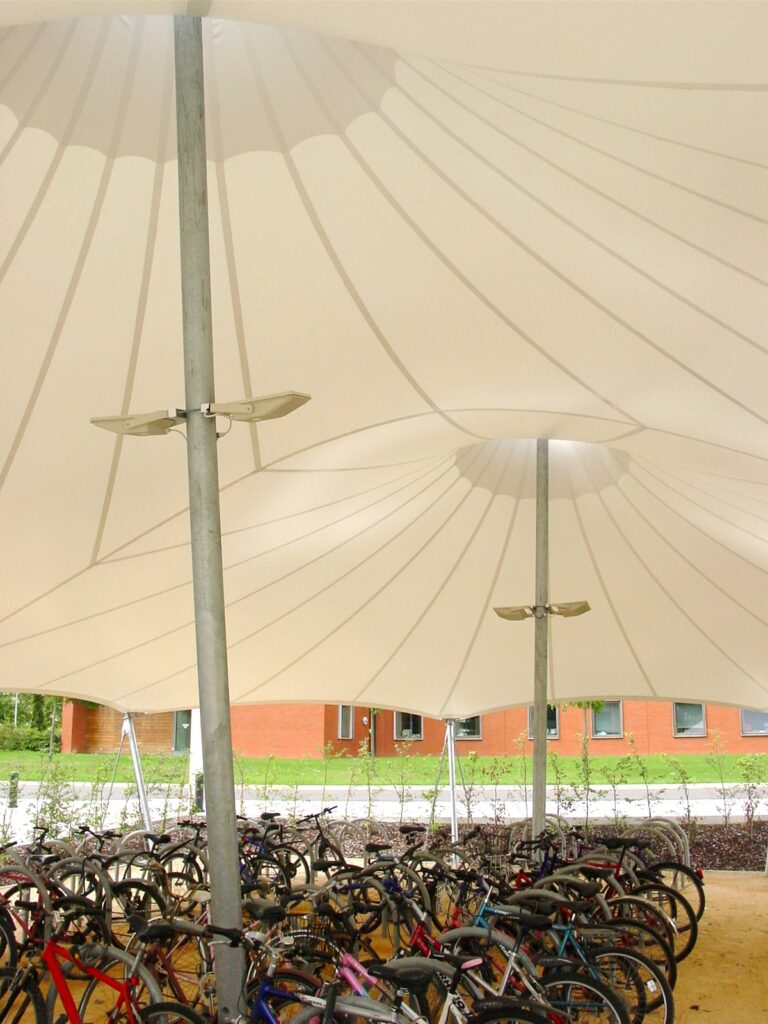
There is no doubt that many of the changes our communities have had to make around Coronavirus restrictions are staying put for a while yet. Faced with an uncertain future around our communal and municipal spaces, UK industries are being forced into becoming creative in not only how they operate but the services they provide. Many of the changes these industries are now implementing may help shape our lives in the future – this gives us the perfect opportunity to reflect on how we want the world to be.
In our previous blog post, we discussed ways in which fabrics and canopies can be used to implement social distancing on a short term basis. In this blog, we talk to Base Structures’ Architectural Consultant, Kevin Hemmings, to discuss the long-term effects of the pandemic, the future of fabrics in architecture, place-making and urban development in a world we’re cohabiting with COVID.

Can you give us a brief introduction to what Base does?
We are tensile fabric experts – from design through to installation. We’re one of the foremost companies in the country dealing with architectural fabric, and the passion for this comes from our ability to be creative in our approach. We’re inspired by creativity and what’s possible, and a lot of our work centres around large municipal spaces – which is why this question of what the future holds for our communal spaces is so interesting to us!

What are the benefits of using fabric in construction?
It goes without saying that fabric is flexible, but in many more ways than one. It’s a relatively affordable solution, and given the uncertainty we’re living in at the moment, that can only be a good thing. Another plus-point is that it works well as a temporary solution – so even if your building or construction plans change in the near to medium future, we can advise on a solution that’ll fit your needs.
On the subject of flexibility, do you think this is important for the success of our urban areas in the future?
In many ways, we’re at the beginning of a journey here. There are certain models that we know after Coronavirus won’t be as appealing – the return of the commute for example is unlikely to be popular with everyone! So I think we’ll have to be more adaptable – spending money on developments that can be altered and tweaked at the drop of a hat. Container architecture, for example, to kick-start new startup and business areas to encourage the economy to bounce back, might be a way forward and is a model that has proven to work in many sectors such as food & drink, markets and mixed use.

How do you think working at home has changed people’s approach to the buildings they spend most of the time in?
I think although it was a shock at first, people have got used to the idea of working at home and even for businesses that have struggled to adapt, people have realised it’s not only possible but enjoyable, and allows a greater flexibility and freedom in life. The role of the office may change in the future, and their existence will become less appealing to a far greater proportion of society, so the spaces around these offices will have to adapt. Fabric structures offer unique solutions to construct, dress and decorate these areas – from one-way systems and queue walkways to stages and large canopies for outdoor eating areas.

How do you think our communal spaces more generally will have to adapt?
In recent years, there has been a lot of discussion around what it means to have a thriving city-centre or town-centre, and what that looks like. The COVID pandemic has sped up these discussions, and suddenly communal centres are having to adapt much more quickly than they would have liked. This is where solutions that don’t suffer from big build costs become more appealing – our city dressing services for example provides communities with an ability to adapt and alter outdoor spaces such as high streets, whilst at the same time potentially keeping in mind Coronavirus restrictions.
A lot of talk about the future of our urban spaces have centred around lower emissions and transportation. What about getting around cities – and can placemaking have an impact on this?
Our previous blog post mentioned the work we’ve been doing on queue shelters and canopies, but there’s been increased interest in things like bicycle shelters and bus-stop shelters too, so the appetite is out there. We all realise the need to lower the amount of cars on the road, for example, but everyone needs to work together to come up with feasible alternatives. This is where place-making comes in and is why we at Base take an interest – with the right environments and the right facilities, using green transport alternatives will become a lot more appealing. Even incorporating a range of pre-designed fabric structures into these areas can help weather-proof them to make alternative transport options more appealing in the rain, for example.

If you are interested in discussing these subjects in further detail, or have a project you’d be interested in taking forward with Base Structures, call our tensile fabric experts or email us, and we will get back to you as soon as possible.









